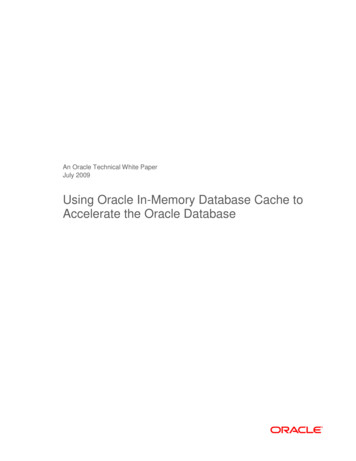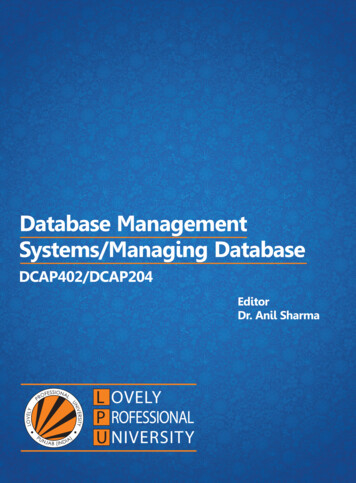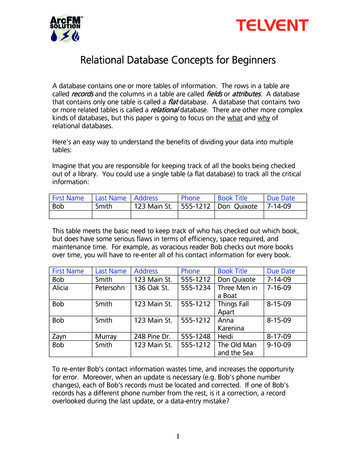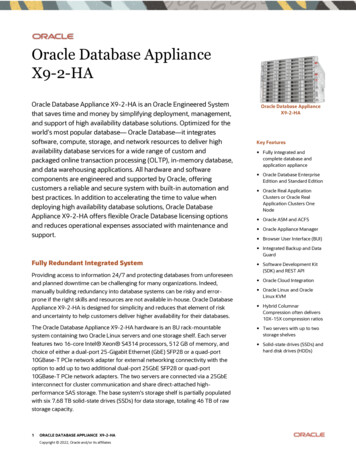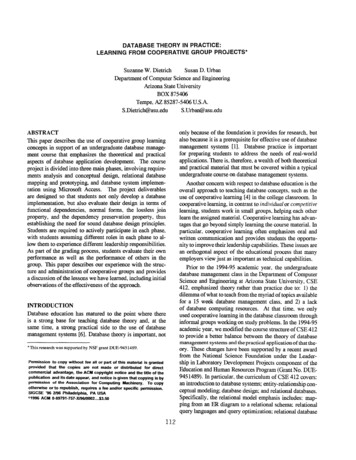
Transcription
LEARNINGDATABASE THEORY IN PRACTICE:FROM COOPERATIVEGROUP PROJECTS*Suzanne W. DietrichDepartmentSusan D. Urbanof Computer Science and EngineeringArizona State UniversityBOX 875406Tempe, AZ BSTRACTonly because of the foundationit provides for research, butlhisalso because it is a prerequisitefor effective use of databasepaper describes the use of cooperativegroup learningconcepts in support of an undergraduate database mrtnagement course that emphasizes the theoretical and practicalmanagement systems [1]. Database practice is importantfor preparing students to address the needs of real-worldaspects of database application development.‘Ihe courseproject is divided into three main phases, involving require-applications.ments analysis and conceptualundergraduatemappingand prototyping,design, relationaldatabaseand database system implemen-establishinga typicalcourse on database management systems.Another concern with respect to database education is thetation using MicrosoftAccess.The project deliverablesare designed so that students not only develop a databaseimplementation,but also evaluate their design in terms offunctionalproperty,There is. therefore, a wealth of both theoreticaland practical material that must be covered withinoverall approach to teaching database concepts, such as theuse of cooperative learning [4] in the college classroom. Incooperative learning, in contrast to individual or competitivelearning, students work in small groups, helping each otherdependencies, normal forms, the lossless joinand the dependency preservation property, thuslearn the assigned material. Cooperativethe need for sound database design principles.learning has advan-tages that go beyond simply learning the course material.InStudents are required to actively participate in each phase,with students assuming different roles in each phase to allow them to experience different leadership responsibilities.As part of the grading process, students evaluate their ownperformance as well as the perfomceof others in thegroup. This paper describes our experience with the struc-particular, cooperative learning often emphasizes oral andwritten communicationand provides students the opportunisty to improve their leadership capabilities. These issues areture and administrationof cooperative groups and providesa discussion of the lessons we have learned, including initialobservations of the effectiveness of the approach.database management class in the Department of ComputerScience and 13@neering at Arizona State University, CSE412, emphasized theory rather than practice due to: 1) thean orthogonalaspect of the educationalemployers view just as importantprocess that manyas technical capabilities.Prior to the 1994-95 academic year, the undergraduatedilemma of what to teach from the myriad of topics availablefor a 15 week database management class, and 2) a lackINTRODUCTIONDatabase e&cationof database computinghas maturedis a strong base for teachingto the pointdatabase theorywhere thereand, at thesame time, a strong practical side to the use of databasemanagement systems [6]. Database theory is important, notcommercialpublicationpermissionis gtantedfor direstspeeificwe onlyship in LaboratoryDevelopmentProjects componentof theEducation and Human Resources Program (Grant No. DUE-advantage,the ACM copyrightnotice and the titfe of theand its date appear, and notice is given that copying is byof the Associationfor ComputingMachinery.TO copyotherwise or to republish,requires a fee and/orSIGCSE ’96 2/96 Philadelphia,PA USAQ1996 ACM 0-69791 -757-X/96/0002 .50.5OAt that time,academic year, we modified the course structure of CSE 412to provide a better balance between the theory of databasemanagement systems and the practical application of that theory. These changes have been supported by a recent awardfrom the National Science Foundation under the Leader-*This research was supported by NSF grant DUE-9451489,Permissionto copy without fee all or part of this materialprovidedthat the copiesare not made or distrfbrdedresources.used cooperative learning in the database classroom throughinformal groups working on study problems. In the 1994-95945 1489). In particular,the curriculumof CSE 412 covers:an introduction to database systems; entity-relationshippermission.ceptual modeling,Specifically,112database desi ,the relationaland relationalmodel emphasis includes:ping from an ER diagram to a relationalschem,query languages and query ldatabase
design theory; transactions, recovery and concurrency con-projects have not focused on the differenttrol; securityin team projects and the way in whichprojects that focus on the practical aspects of databases usingthe opportunity to assume different roles. The projects thatwe examined also did not mention team evaluation of theirown performance and participation as part of the assessmentrelationalprocess.and integrity.The curriculumchanged byremoving coverage of legacy databases, such as network andhierarchical databases, and introducing cooperative groupdatabase technolo .This paper describesour experiencewiththe use ofcooperative group projects in CSE 412. The course projectis divided into three main phases, involving requirementsPROJECTanalysis and conceptual design, relational database mappingand prototyping, and database system implementationusingMicxosoft Access. The project deliverables are designed sodifferentof the gradingperformancegroup.responsibilities.As partprocess, students must evaluatetheir ownas wellThe groupleadershipas the performanceprojectsthe students, most of whomof the semester and is due the last week of classes. Ihchgroup is responsible for identifying the specific applicationto be developed and the expert in the application area toprovide input in the design and development of the database.The project is divided into three phases:1. Requirementsanalysis and conceptual design,2. Relational database mapping and prototyping,3. Database system implementation.of others in thehave been well-receivedappreciateCONTENTThe semester-long group project is assigned the second weekthat students not only develop a database implementation,but also evaluate their design from a theoretical point ofview, thus establishing the need for sound database designprinciples.Students within each group are required toactively participate in each phase, with students assumingdifferent roles over the course of the project to allow themto experienceroles that existstudents can havethe opportunityEach phase has specificbyables.toassessment and technicalThe assessment deliverables,deliver-described in the nextaspects of databasw. Thesection, include group status reports, team assessment i dstudents have also been quite receptive to the overall structureand administration of the projects, much of which has beenrefined several times over the last year.confidential evaluations. The remainder of this section detailsthe technical deliverableof each phase.Phase 1 is the requirements analysis and conceptual designrelate the theoreticaland practicalphase, currently allccated 4 weeks. Each group identifiesAfter describing related work on database group projects,we then elaborate on our approach to the use of cooperativespecific applicationgroup projects.in the applicationThe phases of the project and their deliver-to be developed, requiringthean expert userarea to provide input to the design.Thewith a summary of the lessons we have learned on the use oftechnical deliverables due at the end of this phase includea description of the requirements;an Entity-Relationship(ER) diagram with structural constraints specifid,a list ofcooperativeconstraints that are not captured on the ER diagrm,ables are described, followedand administrativeby a dkxussiondetails of groups.of the structureThe paper concludesgroup projects.summary of processing needs, categorizedand awith respeot toexpected forms, reports and queries. Two weeks into Phase1, the group must hand in both the requirements descriptionRELATEDWORKand the ER diagramOther recent investigationsdatabase managementApenyoclass include the work in [1,5,7,for review.feedback on these intermediateinto teaching an undergraduateThe instructorprovidestechnical deliverablesby thenext class meeting. This feedback is based on the consistency8].[1] describes a two semester database managementof the requirements description and the ER diagram, as wellas the scope of the project. Also, at the end of this phase, eachgroup must give a brief class presentation on the enterprisethat they have chosen for their project. This presentation isgiven by a group-designated speaker, who k typically thegroup liaison to the expert user.Phase 2 is the relational database mapping and prototypephase, which is currently allocated 5 weeks. After receiv ingcourse, where the first course focuses on theory and thesecond course focuses on practice with students working inteams to develop an actual database design and implementation, rather than the one semester course that our work istargeting. Leeper [5] also describes a team design project fora database management course but focuses on the integrationof individual subportions of the project. Other approaches todatabase team projects are described by Saiedian and Farhatdetailed comments on the conceptual design in Phase 1, the[81md by Pigford [71. Saiedian and Farhat describe an approach where each team implements a database applicationgroup may need to refine the ER diagram before beginning the deftitionand prototype of the application.Thein six different phases with documentationdue after eachphase. Pigford [7] describes an approach to database designteams that is close in content to the team approach used inintermediate technical deliverables includea refined ERdlagrm, a relational schema for the enterprise that indicatesthe attributm and keys of each relatiou a list of functionalour curricuh.un. PQford’s work, however, does not describethe organization of the team itself. In fact, most of the abovedependencies holding on the enterprise and a dkussiolu oftheir relational design with respect to normal form, lossless1 13
The roles are assigned primarily at random during phase 1except that the leader is the group member that has had someprior database experience. The roles for the other phasesjoin and dependency preservation properties. This gives thestudents the opportunity to apply the design theory learned inclass to their realistic application.The technical deliverablesat the end of the phase include updates of the intermediateare determinedtechnical deliverables and a prototype of the database implemented in Microsoft Access. This prototype includes theduring differentdefinitionFi eof the schema, includingfined via the relationshipsreferentialintegrity1, where L Leader,T Technicalwindow in Access, and a prototyperolesphases (for the most part). The assignmentof roles for both 4 and 5 memberas de-Advisor.groupsR Recorder,is shownC Checkerinand(Note that 5 member groups have twotechnical advisors.) This assignment results in the phase 1leader having previous database experience being assignedof the forms and reports listed. Fach group member must beresponsible for the prototype (and later implementation)of atleast one form, one report and one query from the processingneeds identified in Phase 1. Only the look and feel of theforms and reports are required for this phase.Phase 3 is the database system implementationso that students are assigned differentas phase 3 technical advisor for the implementation.Otherassignments are possible. We have allowed groups to petitionfor a change of roles in phases 2 and 3, provided that eachgroup member is assigned a differentphase,role.which is allocated 4 weeks. There are no intermediate technical deliverables for this phase (although a detailed groupstatus report is requiredas an assessment intermediatede-liverable). This phase is dedicated to the correctness of theimplementationof the database system, including robust testdata. The technical deliverables due at the end of the phaseinclude a user’s guide for the application and the Accessimplementation.The user’s guide provides: an overview ofthe system, a description of the forms, reports and queries;and an appendixtation,consistingof technicalsuch as the ER diagram,Figme 1: Role Assignmentsupport documen-the relationalGroupsdesign, andgroupa description of the implementationof explicit constraints.The Access implementationis demonstrated by the group,typicallyare formedmemberimportancewithinEachthat acknowledgestheof their membership in the group and the penaltyof withdrawingduring the week of final exams.the second week of class.signs a statementafter groups are formedthe course).(a failingStudents also acknowledgegradethat failureto contribute to the project results in a grade of zero. Eachteam must turn in the appropriate documentationat eachGROUPADMINISTRATIONassigned due date, even if it is incomplete.each phase has an intermediateEach group consists of a team of 4 or 5 students. We handout a questionnaire during the first week of class to gathexinformationon the students to help form groups. Initiallyare using prior database experienceand geographicalThe intermediateto provideweof complementaryand interconnectedThe phase checker is responsibleto the group for improvingSatisfactory performancethe finalin each phase isrequired to revise their work before moving on to the nextphase. The group project is worth 35’ZOof the total coursegrade phase 1 is 8%, phase 2 is 12% and phase 3 is 15%.An individual’sgrade on the group project can be adjusted(as described below).roles to group members is an important component of cooperative learning [4]. The roles that we assign to the membersat each phase include phase leader, phase recorder, phasechecker and phase technical advisor(s).The phase leaderis responsible for coordinatingthe activities of the phase,establishing intermediate deadlines and ensuring the on-timecompletion of the deliverable. The phase recorder establishesan outline and plan for generating the phase documentationby delegating subportions of documentation to other groupmembers, and ensures the correctness and quality of thefinal documentation.is not graded but is usedrequired before going onto the next phase. Teams that do notmeet the minimum requirements for satisfactory work arewithin the Phoenix metropolitan area to form teams such thateach group has at least one member with database experienceand most group members live in the same region (if possible,to facilitate group meetings).The assignmentphase deliverablefeedbackphase deliverable.areaIn particular,and final phase deliverable.At the end of each phase, each group member must submita confidential phase evaluation that evaluates each groupmember’s participation and contribution on the deliverable.This evaluation is both a self evaluation and a peer evaluation.When there is a consensus on the lack of the group member’scontribution, points are deducted from that member’s grade.Generally, the self evaluations are consistent with the peerevaluations, confirmingexcellent contributions.forgathering and reviewing the assessment for each group member, including the checker, and reporting the results of theany lack of participationAt the phase intermediateand final deliverables,as well asa groupstatus report is required.The status report provides thedates and attendance at group meetings during the phase, anovmiewof the progress of the project and a detailed list ofassessment. The phase technical advisor serves as technicalsupport for the group.114
expected and completed contributions for each group member. The group status report is primarily the responsibilitythose groups chosen at random. By the end of the semester,the class was aware of the various projects. However, thefkedback that we received that first semester indicated thestudents wanted to know this information at the end of phase1. In the second offering, we also dedicated a class periodof the phase leader with assistance by the phase recorder.However, each group member must sign the report, indkating that they have reviewed the report for correctness. Thegroup status report gives a good indicationof the divisionat the end of each phase for brief presentations (10 minutes),of labor among group members.At the intermediate deliverable, the report gives the instnctor the opportunity towhich we called phase summaries, by all groups. Again,the group member to present the phase summary was chosenprovide feedback on the delegationrandomly.of responsibilities.the presentations at the end of phases 2 and 3 to be lessuseful.Students also wanted the ability to designate thegroup member to give the presentation. The next offeringthat evaluates how well team members understand the relationship between the theoretical components of the coursematerial and the practical aspects of the course project. Theassessment is performedThe feedback we received indicated that studentsappreciated the presentations at the end of phase 1 but foundAlso required at the end of a phase is a phase assessmentof the class will only have brief presentationsby the phase checker to create andat the end ofencourage an environment in which peers help peers. Theformat for team assessment is provided by the instructor andphase 1 by a group-designatedspeaker. This will free up onemay be a combination of a written quiz, oral discussion questions, or a self-assessment checklist. In all cases, the phasein-class Microsoftchecker must evaluate the responses of each team memberoutside of class. Overall, this works quite well. The in-classweek of class time, which we plan to use in providingAccess laboratoryanassignment. Currently,the students are responsible for learning Access on their ownand provide feedback. The phase checker must also provideassignments,a detailed report of the assessment process as part of thephase deliverable.with some of the more diffkulthowever,willallowus to acquaintstudentsaspects of Access that areuseful for the project.In the first year of the course, the phase checker wasresponsible for checking the relationship of the technicalLESSONSLEARNEDmaterial learned in class to the practice of that theory intheir specific group project. In the first offetig,the phasecheckers were given complete flexibilityfor the design andCSE 412 has been taught for two semesters now with theincorporation of group projects. This section discusses someof the lessons that we learned from this process, erables,group status reports, presentations,assessment and erableswere not built-inof their assessment questions.the second offeringof the class required an assess-ment proposal as part of the intermediateto the fwstDae to the(or lack thereof) of phase assessments in the firstdeliverable.Theoffering.During the conceptual design phase, each groupwas requested to meet with the instructor during office hoursto discuss their design. We formalized this checkpoint inthe second course offering and introduced an intermediatedeliverable for phase 2. The intermediate deliverablea provide an opportunity for the instructor to give useful feedbackfeedback that we received indicates that student’s appreciatethe goals of the assessment but feel that the qpestions shm.ddbe supplied by the instructor rather than the phase checker.The phase checker still has the responsibilityto collect andto the students before they complete the current phase. Weassessment that has been motivatedhave noticed significantassessment questions observed in the first year.improvementliverables since intermediatediscuss the result of the assessment with each group member.The next offering of the course will have instructor-suppliedin the final phase de-deliverableswere added to eachWe plan to take advantage of this change in assessmentphase.The groupstatus reportsin the intermediateto motivate students to use the curriculum materials thathave been developed for the class. A full implementationand finalphase deliverables were introduced in the second offeringof the revised course. In the first offering, we requiredweekly reports both from an individual and from the groupby electronicwouldforgetmail (email).This was a nightmare!to send an emailby tine (best of the)of a company enterprise from the course textbook [3] hasbeen implemented by an undergraduate assistant to give thestudents an Access example of an enterprise with which theyare thoroughly familiar. Unfortunately, most students did notlook at this example. To facilitate the students’ exploration ofStudentsand when they did (moreoften than not), the reports were not detailed enough to knowthis example implementation,which group member was responsible for what. The detailedgroup status reports consisdngof the required format workedsuppliedtheory to their specificwell in the second course offering.We have tied two forms of presentations in the first year.In the first offering, we dedicated a class period at the endwe plan to have the instructor-assessment consist of two parts: one that relatesapplicationand another that relatestheory to the company enterprise and its implementationinAccess. We feel that this new assessment in conjunctionwith the proposed in-class (one week) laboratory on Acxesswill provide the students with a better foundation for theprototyping and implementation phases of the project.of each phase for detailed presentations (20-25 minutes) bysome (2-3) groups chosen at random and by members of115
extra effort is definitely worthwhile.The students appreciate the opportunity to use a real database product and anoverwhelming majority of the students appreciate the groupexperience, learning far more than database topics horn theirfellow group members. As an instructor, the group projectsAnother lesson that we learned includes the electronicdissemination of the course material. In the first year, thesample phase deliverables were only available in hard-copyform through reserve in the library. (This was partly due totime constraints on the development of these materials thatprohibited some electronic form of dissemination.) Unfortunately, we had to deal with out-of-order or missing pages.By establishing a homepage on the world wide web at thefollowing address:http://www.eas.asu.provide an additional avenue of communicationwith thestudents that gives the instructor the opportunity to know thestudents better.ACKNOWLEDGEMENTSeciul-cse4l2This work was supported by NSF’s DUE ILI-LLD(DUE945for our database managementprovideclass CSE 412, we not onlythe students at ASU with the curriculumbut the entire educationalcommunity1489).We wouldliketo thankprogramthe studentswho took CSE 412 in the 1994-95 academic year for theirmaterialconstructive feedback. We are indebted to Rene Chan forhis invaluable support in developing curriculum materialsalso has access to thedetails of how we organize and administer the group projects.and being the MicrosoftWe have includedin the first year of the grant. We also wish to express ouraccess to all of the forms for the vari-ous phase deliverables,enterprise in Microsoftthe implementationof the companyAccess, and the sample phase deliv-erables related to the companyalso includes informationthat provides a Relationalquery languages:for theiralgebra, domain relationalREFERENCES[1] K. Apenyo,cal-“A Database Sequencetice,” ACM SIGCSE Bulletin,calculus and SQL. This tool has beenTheory Then Prac-vol. 22, no. 4, December1990.[2] S. W. Dietrich, An Educational Tool for Formal Relational Database Query Languages, Computer ScienceEducation, vol. 4, pp. 157-184,1993.[31 R. Ehnasri and S. Navathe, Fundamentals of DatabaseSystems, 2nd edition, Benjamin Cummings, RedwoodCity, 1994.[41 D. W. Johnson, R. T. Johnson and K. A. Smith, Active Learning:Cooperation in the College Classroom,academic year shows a substantial increase in the numberof A, B and C letter grades earned by the students with aInteractionsubstantial decrease in the number of D, E and[51 R. Leeper,W letter grades. The number of withdrawals (W) is obviouslyrelated to the assignment of a failing grade (E) in the courseonce the instructor’s signature is required for a withdrawal.(Students may withdraw without an instructor’s signaturethrough the third week of classes.) The few failures in the firstBook Company,“AProject1991.Coursein Database,”ACMSIGCSE Bulletin, vol. 22, no. 1, February 1990.[61 A. Metro, What to Teach about Databases, Panel Discussion, Proc. of the 1993 ACM SIGMOD Intl. Conf. onManagement of Data, pp. 420and Evaluation7] D. V. Pigford, “The Documentationyear are due to students who failed to participate in the classarid the group project, usually during the implementationphase. The effected groups must meet with the instructor toof Team-OrientedDatabase Projects,”Bulletin, vol. 24, no. 1, March 1992.ACM8] H. Saiedian and H. Farhat, “A Team-Oriented,SIGCSEProjectIntensive Database Course,” ACM SIGCSE Bulletin, vol.detail a reduced implementationplan based on the loss ofthat group member. Although the students’ letter grades arehigher (due to the group project), the students’ individualperformance on exams has decreased. This decrease appearsto be due to a focus on implementing the group project rather23, no. 1, March 1991.than studying for exams.We are considering exploringcooperative learning techniques to motivate groups to studytogether for exams, The students’ individual performanceon the RDBI assignments appears unchanged. More detailedevaluation is beyond the scope of this paper but is scheduledas part of the contributionsTjahjadithe CSE 412 homepage.The web pageused for several years at ASU as an intricate part of thedatabase management class. RDBI assignments are givenstrictly as individualstudent assignments, complementingthe group work that the students experience as part of thecourse project.An initial observation based on ex amining student gradesfrom the first year of the group project to the previouscorrespondingto Patricia Baker and Michaelwork on establishingon the RDBI educational tool [2]DataBase Interpreter for relationalrelationalculus, tuple relationalenterprise.gratitudeAccess technical advisor to the classof the grant.We have also learned that, although the group projectsadd a substantial effort on both students and instructor, the--llb
Ihch group is responsible for identifying the specific application to be developed and the expert in the application area to provide input in thedesign and development of database. The project is divided into three phases: 1. Requirements analysis and conceptual design, 2. Relational database mapping and prototyping, 3.




